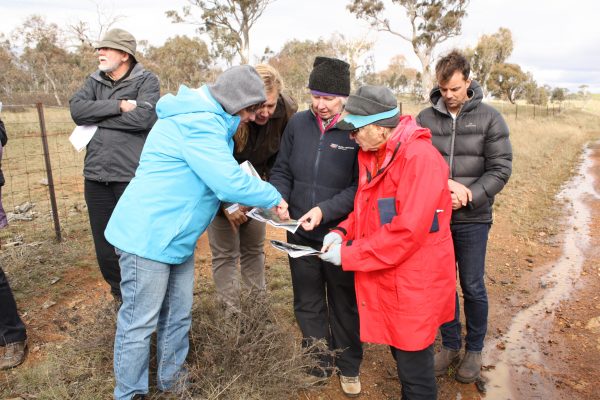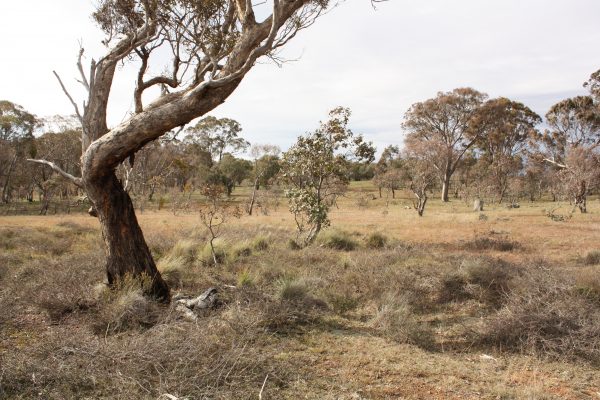Ginninderra News
 17 Jun 2016
17 Jun 2016
Site tour leads the conservation conversation
The conservation conversation was front and centre as members and experts from ACT environmental groups visited CSIRO’s Ginninderra Property on 6 June.
The question of: “How can we conserve and restore important environmental features within and beyond the boundaries of a proposed future urban development?” was top of mind as the group visited nine key sites across the property.
CSIRO researchers and expert consultants explained the findings of ecological surveys and their interpretation of key environmental features on the site, while also seeking initial advice and ideas from participants who included members from the Conservation Council ACT Region and its Biodiversity Working Group, Friends of Grasslands and the Ginninderra Catchment Group.

Studying the map during the site tour.
Throughout the tour, participants studied maps of the Ginninderra property showing CSIRO’s initial assessment of developable land (360.8 ha or 51% of the site), potential developable areas under review (129.4 ha, 18%), areas primarily protected by current legislation (130.9 ha, 19%) as well as additional areas CSIRO has set aside to protect conservation and heritage values (80.5 ha, 12%).
Some of the key features for mandatory protection are:
- high value Box Gum Grassy Woodlands and Derived Native Grasslands on the north of the site
- areas of Derived Native Grasslands where studies have recorded the presence of Golden Sun Moth and Striped Legless Lizard
- a Box Gum Grassy Woodland and Scribbly Gum Woodland area surrounding a nesting site of the Little Eagle
- an area of Box Gum Grassy Woodland adjacent to Owen Dixon Drive
- regulated trees and cultural heritage features
Other areas or features earmarked by CSIRO for protection include:
- the corridor (riparian zone) along Halls Creek and drainage lines
- areas of Scribbly Gum Woodland and Box Gum Grassy Woodlands that contribute important environmental values but are not technically protected under legislation
- important buffer zones and areas that add habitat and wildlife connectivity to protected areas, both on the site and in adjacent areas
Some important questions raised on the site visit included the need to define the boundaries for conservation areas and clarify the buffer and transition zones between areas under development and those under conservation. Road access within and to the site will also be an important factor in realising conservation goals.
Establishing sound principles for conservation and development from the outset was seen to be an essential ingredient for success.
So, coming back to the question: “How can such conservation and even restoration be successful in close proximity to an urban development?’” Based on early advice from conservation experts – it won’t happen by accident – but rather through diligent assessments, and applying clear principles and careful planning and implementation.
CSIRO is keen to do exactly that and to develop principles and plans with experts and the broader community through a participatory planning process.
The next steps are to further develop these conservation principles with the same groups through a workshop in late June and to follow that up with some broader community engagement in July.
The environmental principles and plans will then form part of the briefs for the eventual joint venture development partners selected by CSIRO.

Rob Armstrong, Senior Ecologist with Umwelt, talks about an area where threatened species protection would apply.

High value Grassy Box Gum Woodlands on the north of the site.
As you have admitted via email, you have killed kangaroos on this property over the last 4 or 5 weeks.
I have some questions for you,
– How can you claim to be protecting grasslands or crops (as you did) when you have hundreds of sheep on the same land?
– How many kangaroos are involved; the number prior to this killing, how many already killed and if they are not all dead now, how many more are you targeting?
– Why were we nearby residents not given prior warning that there would be shooting at night nearby?
I did wonder about the sound of shooting at night & thought I must have missed any prior advice published. I don’t have a view either way on the exercise as I do not have all the information leading to the decision. I can only trust the requirement was a result of proper assessment and that it was undertaken professionally. Sheep are easier to contain with fencing than kangaroos, so I expect this will be highlighted in the response you receive.
Dear Mr O’Shaughnessy,
As in past years, we continue to manage the property as an agricultural research farm with important long-term trials in place.
We maintain sheep on the property as an important part of pasture and dual purpose cropping research consistent with mixed farming in temperate Australian agriculture.
The native grassland is not used for agricultural research, but managed for conservation of an endangered vegetation community – the Box Gum Grassy Woodlands and its highly diverse ground layer of wildflowers and native grasses.
Native grasslands are being overgrazed by kangaroos and this impacts sensitive species and increases levels of soil erosion.
Kangaroo management is an important part of the overall management of the property, just as it is on many Australian farms. Kangaroo numbers are managed in line with strict protocols and guidelines to protect farm and environmental assets.
CSIRO adheres to the licence conditions specified by ACT Parks & Conservation and this includes our obligation to inform ACT Government and contact ACT Police.
The ACT Government has provided you with information about Kangaroo numbers.